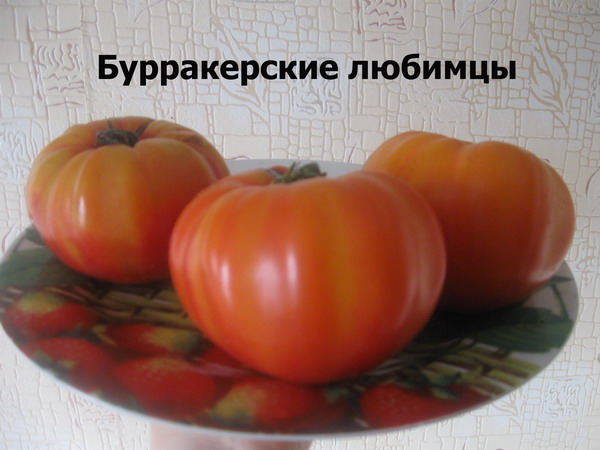 Surely, hunters for rare collection varieties have already tasted the taste of the unsurpassed tomatoes of the Burraker Favorites variety. Now it’s the turn of those gardeners who also want to grow an unusual tomato variety on their plot, characterized by high productivity, excellent taste and an original two-color fruit color. Meet the "Burraker favorites"!
Surely, hunters for rare collection varieties have already tasted the taste of the unsurpassed tomatoes of the Burraker Favorites variety. Now it’s the turn of those gardeners who also want to grow an unusual tomato variety on their plot, characterized by high productivity, excellent taste and an original two-color fruit color. Meet the "Burraker favorites"!
Content
Grade characteristics
Burracker’s Favorite tomatoes were naturally bred by American scientists. The variety is named after the famous area of Burraker - the picturesque foothills of the Blue Ridge. In the south, cultivation of this tomato is produced in open areas. In the Middle Strip and Siberia, only greenhouse cultivation is preferred.
The producer claims mid-ripeness of the variety, although the experience of summer residents of Russia suggests that it is rather a medium-late variety, ripening 120 days after seed germination. Tomatoes reach biological maturity by 130-135 days.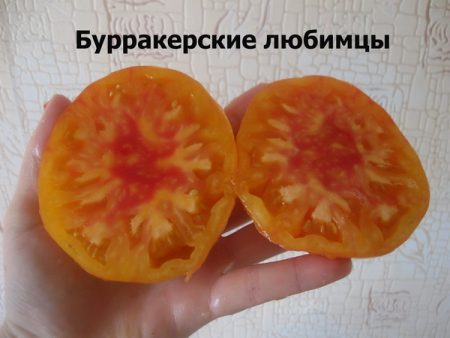
Plants of Burraker’s pets are indeterminate in nature, that is, the plant grows without ceasing throughout the growing season. In the open ground, bushes rise to a height of 1.5 meters, while in a greenhouse their growth can exceed two meters. It is recommended to form bushes in one or two trunks, as well as tie the stems and fruit-laden branches to a strong support. Seedling planting scheme - 3 bushes per square meter. Bushes do not form a stem; regular pinching is required. The trunk grows with 8-9 flower brushes, the first of which is formed above the seventh leaf. The oblivion is average.
Each brush forms 3-4 large, fleshy, weighty fruits, weighing from 300 to 600 grams. Tomatoes are rounded, slightly flattened.
Thick peel is not prone to cracking. At the stage of full maturity, it has a bicolor color - golden yellow with red uneven stripes. The flesh has a similar shade. Tomatoes are stuffed with a lot of sugar pulp. The taste of Burraker favorites is excellent. Tomatoes are very sweet, moderately watery, with a small amount of seeds. Tomatoes are mostly consumed fresh, as it is simply impossible to break away from juicy and sugary vegetables. All kinds of sauces, tomato pastas, juices are also made from them. And for conservation it is better to use other, less large-fruited varieties.
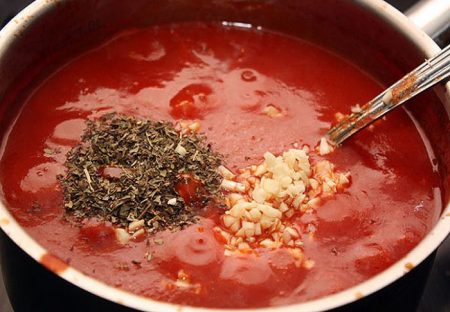
In addition to the perfect taste and interesting appearance, the variety “Burraker favorites” is also endowed with high resistance to various tomato diseases. Tomato bushes can easily endure multi-day drought, sudden cooling, weekly rains and lack of sun.
The variety also stands out for its high productivity, which, meanwhile, is highly dependent on growing conditions, top dressing, and soil composition. On average, up to 10-11 kilograms of selected tomatoes are harvested from one square. Although this is far from the limit.
Grade advantages:
- large-fruited;
- tomatoes are endowed with a very pleasant taste with a fruity finish ;;
- high resistance to diseases;
- tolerates bad weather.
Cons of the variety:
- constant garter to the support is required;
- bush formation, frequent pinching;
- tall plants often need to be fed.
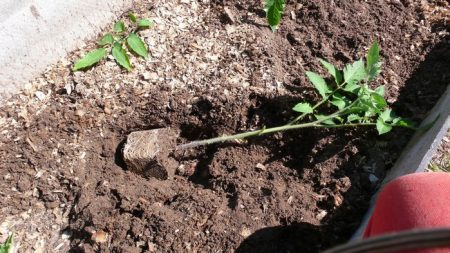
Growing Features
The agricultural technology of growing tomatoes of the Burrakersky variety is quite traditional. Obtaining a plentiful harvest begins with the backlog of small seeds of tomatoes for seedlings. Seeds are sown in mid-March, taking into account the estimated term for planting tomatoes for permanent residence. It must be borne in mind that mature seedlings that can safely survive the transplant and quickly take root in new conditions should be at least 65-70 days old. If you plant more “young” seedlings, there is a risk that fragile thin shoots will not accept in the new soil and the external environment will quickly freeze them. Overgrown seedlings are also dangerous to plant - it will hurt for a long time, and the development of the bushes will slow down, therefore the crop will ripen much later.
Before sowing, seeds must undergo a series of procedures that will disinfect them from possible pests and improve seedling. Seed treatment includes:
- Soaking seeds in a solution of manganese (then the seeds are washed and dried).
- Treatment with a growth stimulant (if there is concern about the quality of the seeds or their age).
- Germination of seeds (seeds are placed in a damp cloth so that they hatch and shoots appear in the ground a little faster).
For seedlings, special land is harvested. The soil should consist of three components:
The soil mixture must be sterile. To do this, before planting, it is calcined in the oven at a temperature of 110-120 degrees; shed with a hot solution of potassium permanganate.
The earth is packed up in seedling tanks, which are usually large seedling boxes. Seeds are sown in long rows with an interval of two centimeters. Between the rows left a backlog of 4 centimeters. Seeds are deepened by 1 centimeter, and sprinkled with dry earth on top. After crops watered (it is better to use a spray bottle). Boxes with future seedlings are covered with film or glass and placed in a lit, warm place. The first shoots appear in 5-7 days.
Note: sowing is carried out in moist soil.
The optimal conditions for the germination of seedlings are as follows:
- Temperature - + 23-25 degrees on seedling days. Then it is reduced to 18-20 degrees. Two weeks later, restore the former temperature.
- Lighting - at least 12-14 hours a day. If the daylight is still short, then the seedlings need to be illuminated artificially. A long stay of seedlings in the shadows is fraught with excessive stretching and thinning of the stems. Such seedlings will not give good results in the future.
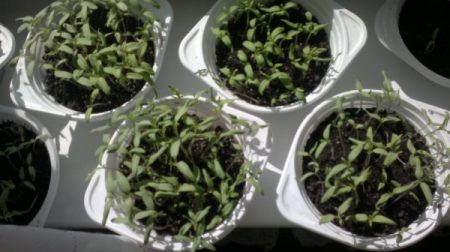
- Humidity - it is optimal to keep the soil in a semi-moist state, preventing it from drying out very much. It is also not recommended to arrange a swamp - fungal microorganisms will quickly begin to multiply. It is worth regularly airing, watering the plantings only with warm water from the spray gun as the top layer of the earth dries up.
After the seedlings acquire the first leaves, it is planted in separate containers. This will contribute to the rapid growth of strong healthy seedlings. A week after the picking, tomatoes are fed for the first time with a complex mineral fertilizer.
Landing
To plant the seedlings on the bed was less painful, young bushes should be prepared for this process - that is, harden. Hardening begins a couple of weeks before an important point. To do this, in the room where the tomatoes live, gradually lower the temperature, bringing it to the street. Daily seedlings are taken out to the veranda or balcony, so that the young shoots get used to new external factors.
Tomatoes are planted in the greenhouse in early May. The land for the beds is prepared in advance, a good portion of humus or compost is brought into it. Do not forget to supply the soil with mineral components (for example, superphosphate). Wells for seedlings are not too large, up to 25 centimeters in diameter and 15 centimeters deep. Between the holes - 50-60 centimeters. At the aisle leave 70 centimeters. It is recommended to place no more than 4 plants on one square meter. It is best to build a bed in a checkerboard pattern. Seedlings, planting, are slightly deepened to contribute to the growth of additional roots. After planting, the bushes are not watered, leaving alone for 7-10 days.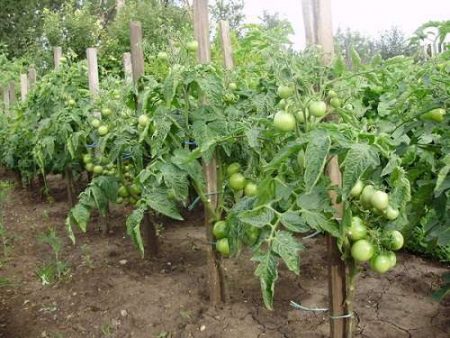
If Burraker’s pets landed in open ground, then until the middle of June, plantings should be kept under temporary film shelter.
Care
Burraker tomatoes are grown in Russia mainly in greenhouse conditions, where an ideal environment is created for the growth of strong and powerful bushes, the formation of numerous fruits. Caring for tall tomatoes in a greenhouse is somewhat different from open ground. This has its own nuances, neglect of which can spoil the impression of the variety due to the receipt of low-quality tomatoes.
Basic rules for caring for Burracker pets:
- When growing tomatoes in a greenhouse, you must carefully monitor the temperature and humidity. A prerequisite for the proper development of plants in the greenhouse is a comfortable temperature. Therefore, it is so important to observe the temperature control: + 23-25 degrees during the day and + 18-20 degrees at night. Optimum humidity is 55-65%.
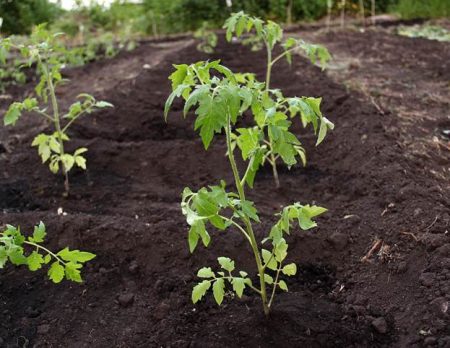
High humidity is especially dangerous, which is fraught with the development of fungal diseases. This is the main disadvantage of cultivating vegetables in a greenhouse. But you can achieve optimal humidity by regularly ventilating the beds. On hot days, the doors and windows of the greenhouse are opened to avoid the excessively high temperature at which plants can throw off their ovaries and their pollen becomes sterile.
- In the first two weeks after planting a tomato in the garden, you should not get involved in watering and top dressing. Feeding plants can lead to fatliquoring of bushes: growth of abundant green mass, stretching of stems. All this provokes a delay in the development of the bush in terms of flowering, the formation of ovaries. As a result, the crop will be able to get much later than the declared date.
- Watering tomatoes is rare, but very plentiful. Mandatory under the root, excluding the ingress of water on the stems and leaves. If the greens are often wet, soon a harmful fungus will appear on it, which it is impossible to get rid of. Wet leaves often rot, deteriorate, turn yellow, and, of course, all this affects the health of the plant as a whole. Since moisture evaporates in a greenhouse for a long time, it is enough to arrange watering once a week. You can determine the need for irrigation by the degree of moisture in the earth - if it has already dried up enough, then it's time to “water” the plants.
The amount of watering should be increased during the flowering of fruit formation.
note: the first 7-9 days of beds with tomatoes do not water at all.
- In a state of constant moisture, the soil quickly compacts, as a result of which its throughput decreases. Water and air fall poorly into the depths, causing a delay in the development of plants. Excessively dry earth, on the surface of which a crust forms, also leads to these consequences. You can correct the situation using the loosening technique. It must be carried out after watering, so that with the help of a tool (hoe or chopper) to break up the resulting lumps of earth. Loosening instantly saturates the soil with oxygen, and moisture immediately gets to the roots.
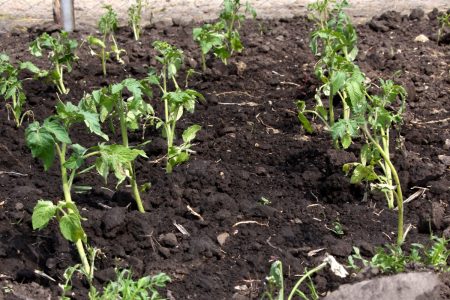
- To prevent frequent drying of the earth and retain moisture in the soil for as long as possible, gardeners often resort to mulching. This method allows you to maintain the desired humidity and temperature of the earth and prevents weed growth. As mulch, you can use mowed grass or sawdust, which, decaying, will serve as a natural fertilizer.
- Proper bush formation can double crop yields. Burraker tomatoes are preferably carried in one or two stems. To form a bush in one stalk is much easier, because for this all the stepsons are cut off, leaving only the central trunk. With double-barreled guidance, they also leave one additional shoot growing under the first flower brush.
Stepchildren need to be removed regularly, breaking off at a time 3-4 pieces, no more. Shoots that have not reached a length of more than 5 centimeters are subject to removal. The longer the stepsons, the more “painful” the plant is from the removal procedure.
Stepson should be on a sunny day, in the first half, so that in the evening all the cut-off places have time to dry out. You need to start with healthy bushes, then moving on to less developed bushes. This is done in order not to transfer a possible disease from fragile plants to strong ones.
- Often large double flowers appear on the first leaves, which indicate that the plant does not develop properly. Of these flowers, poor-quality fruits will subsequently form. In addition, they inhibit the growth and development of the plant. Therefore, the flowers are subject to mandatory removal.
- The lower leaves, which cover the ground from sunlight, are also subject to removal. They also remove all damaged and yellowed leaves from the bush, as well as sterile brushes that do not carry any function, but take on themselves the lion's share of nutrition. For one procedure break off 2-3 leaves, no more. The procedure is carried out once a week.
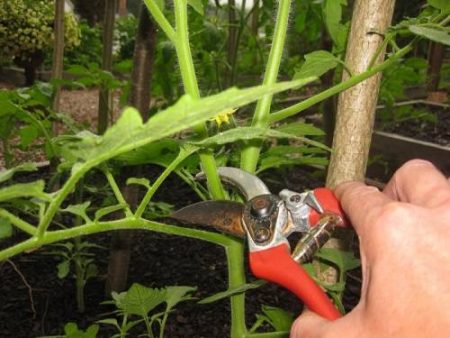
- Strong strong bushes of Burrakersky pets should be often nourished, observing the norms of making fertilizing. In the first period, when the plant is rapidly growing, rapidly growing green mass, it requires a large dose of nitrogen, which is responsible for the splendor of the aerial part. Immediately the field for planting tomatoes on the planting bed is flavored with mullein diluted with water or use the Kemira station wagon. During the period of abundant color and the formation of tomatoes, plants are in great need of mineral supplements containing potassium and phosphorus. During flowering, foliar replenishment with boric acid will not be superfluous in order to avoid shedding of flowers.
Fertilizing is combined with watering, since the application of fertilizers on dry ground can provoke a “burning out” of the roots.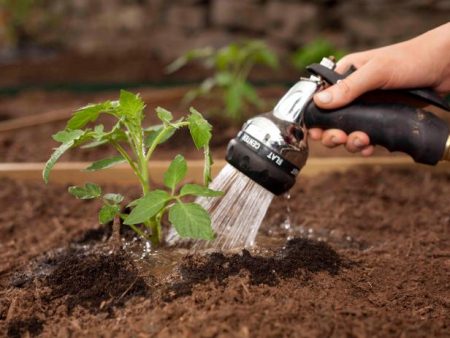
As a prevention of late blight, the bushes are treated with copper chloride or Bordeaux liquid.
- Tall varieties are usually grown to produce very large tomatoes. If you also pursue this goal, then you need to remove excess flowers and ovaries. Yes, there will be fewer fruits, but they will grow much larger, as they took advantage of additional nutrition.
Fact: the fewer flowers on the brush, the larger the fruits.
- Burraker tomatoes require frequent garter. It is better to use a trellis for this purpose. Tie not only the trunk, but also heavy branches. The bush should be wound around the support clockwise so that the stems do not tighten. When tying up, it is worth considering that the shoots are constantly growing, which means that their thickness is increasing. Therefore, it is impossible to tighten the branches with a rope.
- In open ground, tomatoes are pollinated naturally. In the greenhouse, they need help.To do this, shake the branches with inflorescences and spray the air with water from the spray gun.
- Pinching the tops of all stems will help accelerate the ripening of the formed fruits. Do this about 50 days before the final harvest. Then gradually reduce watering and increase the dose of potash fertilizers. In mid-September, the bushes are removed from the trellis and laid out on the ground.
Reviews
Alfia
“Burraker favorites” is one of the constant tomatoes in my garden. Tomato has excellent taste and good yield. Fruits are yellow-red, colored, beautiful, fleshy, few seeds. Sweet, but we plucked them unripe, I think that in the ripened state (it was on the bush) the taste poured even more.
The bushes are very tall in the greenhouse - under two meters. In open ground just above a meter. The bushes are not very branched, so there is not much hassle with a garter. Led plants in two trunks. There are a lot of ovaries on the bush. They perform well both in open beds and in sheltered ground. In general, a grade for a solid five.
Anastasia
One of my favorites. Tomatoes of a very unusual color. And the taste just strikes them - so juicy, sweet, sugar straight. Although, overripe in salads, tomatoes directly fall apart. Bushes knit very well. Each has 8-10 large tomatoes, weighing approximately 350 grams. True, in the second wave, tomatoes are slightly smaller in size. Fruiting begins in mid-July and the end of September forms fruits. Our tomatoes are not stored for long, because the skin is not too dense, and the inside is very watery.
Daria
Planted tomatoes of this variety for two years in a row. Loved the variety. Even in our Siberian conditions, it shows itself well. She grew up in a greenhouse, the height of cuts is 180 centimeters. Tied to a trellis. She led into one trunk. On each bush, 10 tomatoes are tied up on average. I got a medium-late variety, the first tomatoes appeared in August only. But this is understandable, since we have little sun, so the vegetation is very long in all cultures. Fruiting is long, uneven. In October, the last fruits were removed. The most valuable thing in this variety is the unusually tasty tomatoes. I've never eaten anything like this before. These tomatoes will make any dish chic. And then I will plant this variety.
Lucia
Last year I tried to plant this variety. The fruits are all large, weight from 300 to 600 grams. Very tasty, fleshy, heavy. Plants are strong, powerful, one and a half meters tall. Fertilized not often, but apparently enough, because the crop seemed to me good. The bushes did not hurt, no insects took root on them. In general, unpretentious, resistant variety. This year, again planted seeds for seedlings.

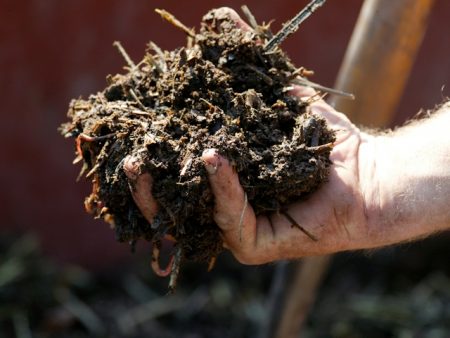



 Low-growing tomatoes, without pinching: 5 of the most delicious varieties
Low-growing tomatoes, without pinching: 5 of the most delicious varieties Why tomato seedlings grow poorly
Why tomato seedlings grow poorly We grow a tomato in a shell
We grow a tomato in a shell Growing tomatoes without watering according to the method of Kazarin
Growing tomatoes without watering according to the method of Kazarin